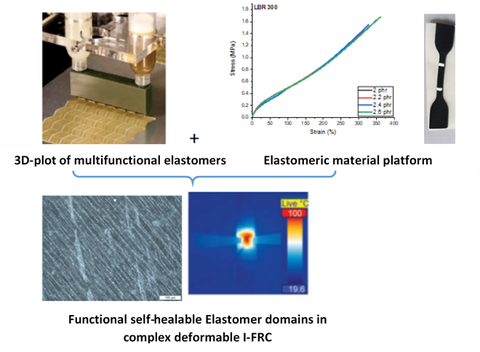Subproject 3: Multi-functional elastomer 3D plot for the locally controllable integration of functional elastomer domains in complex deformable I-FRC
Table of contents
Motivation
To achieve I-FRC with spatial deformation patterns, the locally controllable integration of functional elastomer domains in complex gradient 3D textile structures is required. Therefore, innovative generative manufacturing concepts for the formation and consolidation of composites must be developed that simultaneously ensure preform production and form stabilization of rubber components due to precisely initiated cross-linking by local energy input. In order to extend the operating life of elastomer components in I-FRC, self healing effects can be activated by means of alternative cross-linking concepts. Hence, the processing properties of elastomer materials must be adapted to the requirements of the multi-functional elastomer 3D plot.
State of the art and preliminary research
Multi-material 3D printing of highly deformable polymer structures for the realization of pneumatically actuated soft robotic walkers, matrix-integrated sensor structures or the local implementation of actuating ferromagnetic elastomer domains are subject to intense current research [1-3]. Typically, well-established materials and cross-linking concepts are employed for polydimethilsiloxane and polyurethane elastomers, although their combination with functional or reinforcing textile structures has not yet been investigated. Within the 1st cohort, an elastomer platform based on printable diene liquid rubbers was developed and characterized; additionally, it was proven that it is suitable for use as matrix for planar, highly deformable I-FRC with actuated SMA (shape memory alloys). Upon addition of particle systems, functional piezoresistive and magneto-sensitive liquid rubber elastomers with defined deformation characteristics could be generated. The self-healing capacity of ionically cross-linked elastomers by intrinsic heating was investigated and verified by the applicant and his research team [4,5] and shall be transferred to the functional elastomer components in I-FRC. Thus, there is a considerable demand for research regarding the 3D manufacturing of diene rubber based functional elastomer domains and their integration into spatially deformable composite structures.
Scientific question and project objectives
The main objective of SP 3 within the 2nd cohort will be the investigation and design of a generative technology for the locally controllable (meso scale) defined arrangement of multi-functional highly viscous elastomer precursor domains in hierarchically structured 3D textile structures as well as their in situ cross-linking in a generative I-FRC construction process. To achieve this goal, locally and temporarily controllable energy input mechanisms (e.g. focused IR LED radiators) that are adjusted according to the specific cross-linking mechanisms must be researched and technologically implemented. There will be a focus on using electroactive and dielectric elastomers for the realization of defined 3D deformations with high switching frequencies (>10 Hz), whereby alternative cross-linking concepts for the implementation of self-healing effects for elastomer functional components will also be taken into consideration [6].
References
| [1] |
J. Herzberger et al.: Polymer Design for 3D Printing Elastomers: Recent Advances in Structure, Properties, and Printing. Progress in Polymer Science 97(2019)101144 |
| [2] | J.J. Schwartz, A.J. Boydston: Multimaterial actinic spatial control 3D and 4D printing. Na-ture Communications (2019)10: 791 |
| [3] | X. Zhao et al. Printing ferromagnetic domains for untethered fast-transforming soft materi-als. Nature Vol. 558 (2018) 274 |
| [4] | H.H. Le et al. Triggering the self-healing properties of modified bromobutyl rubber by intrinsically electrical heating. Macromolecular Materials & Engineering 302 (2016) 1600385 |
| [5] | A. D. Sarma et al. Determination of phase specific localization of carbon black in ternary rubber blends: A macroscopic approach by fourier transform infrared spectroscopy (FTIR). Polymer 150 (2018) 64 |
| [6] | L. Duan et al. A dielectric elastomer actuator that can self-heal integrally. ACS Applied Material and Interfaces 12 (2020) 44137 |
Contact
Institute of Materials Science (IfWW), Professorship for Rubber Materials, Faculty of Mechanical Science and Engineering at TU Dresden
Leibniz Institute for Polymer Research Dresden e.V. (IPF)
 © Christian Hüller
© Christian Hüller
Mr Prof. Dr.-Ing. Sven Wießner
Head of Research Division "Elastomers"
Besucheranschrift:
Leibniz-Institut für Polymerforschung Dresden e.V., Leibniz-Institut für Polymerforschung Dresden e.V. Hohe Straße 6
01069 Dresden
Deutschland

